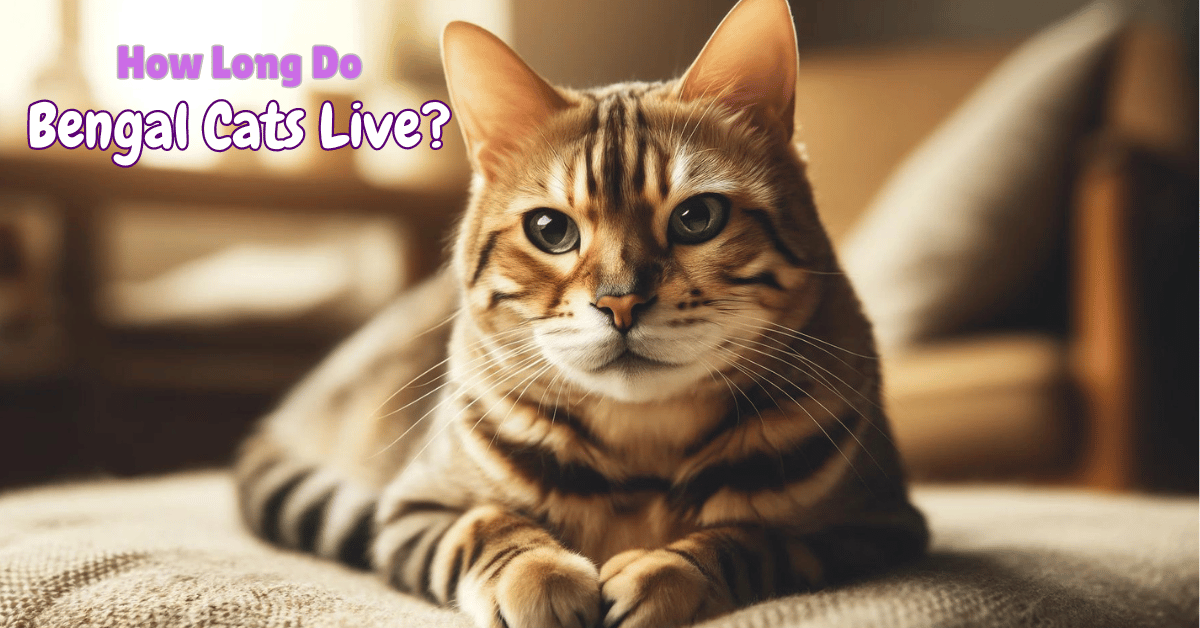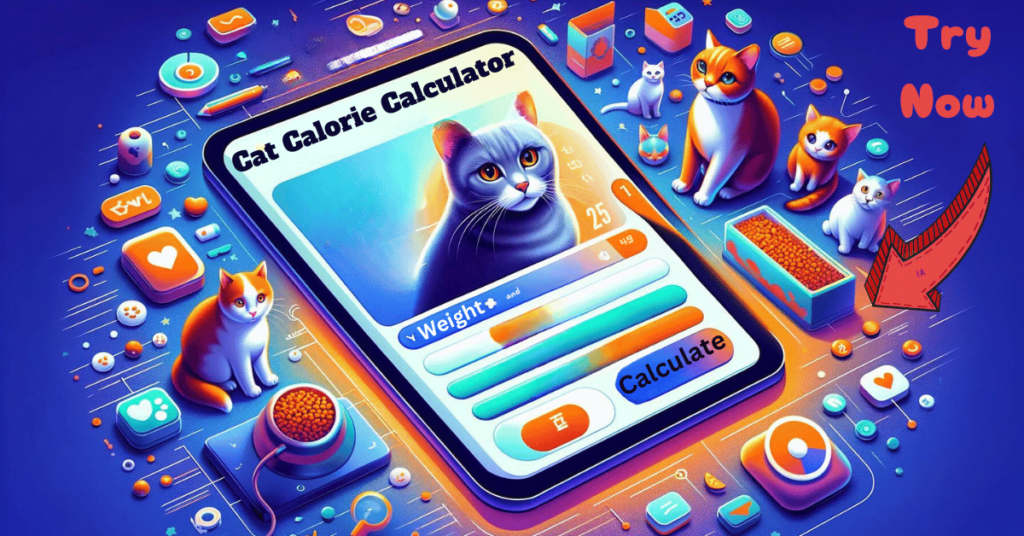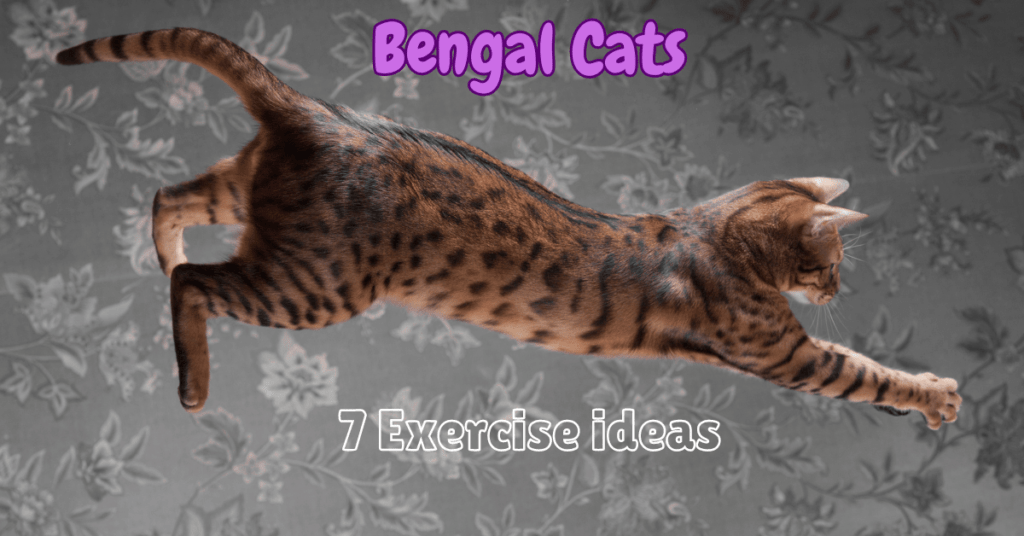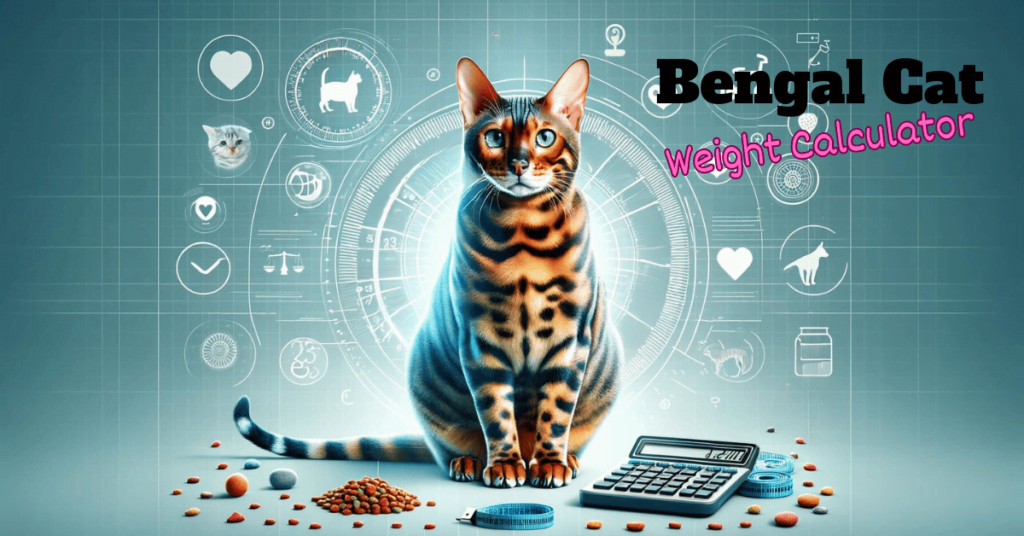This post contains affiliate links and I will be compensated if you make a purchase after clicking on my links.
How Long Do Bengal Cats Live? An Introduction to Their Lifespan
One common question that potential and current Bengal cat owners often have is: how long do Bengal cats live?
Understanding the lifespan of these magnificent felines is crucial for providing them with the best possible care and ensuring they lead long, healthy lives.
Average Lifespan of Bengal Cats: What to Expect
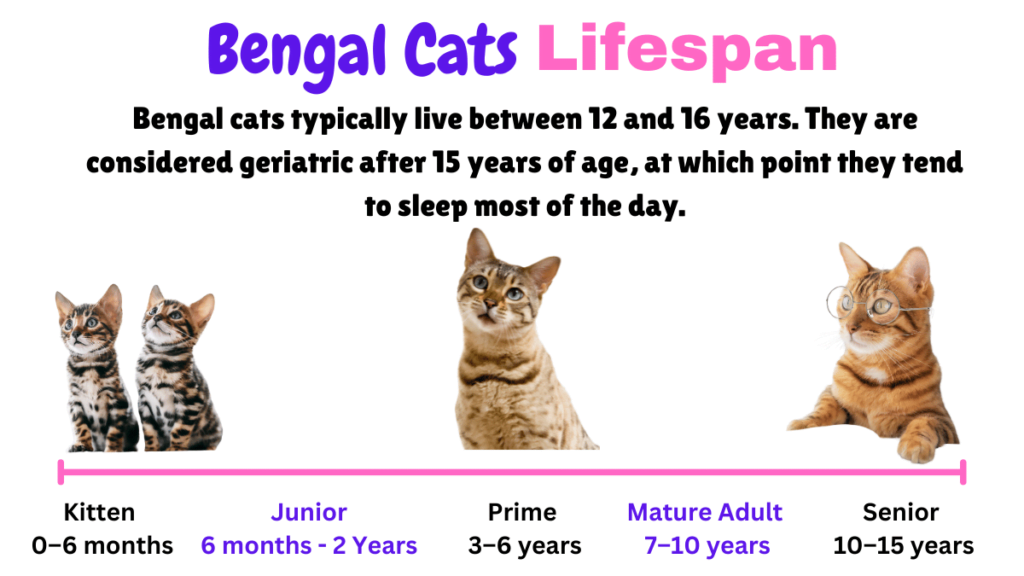
When it comes to lifespan, Bengal cats typically live between 12 to 16 years. However, with excellent care and a bit of luck, some Bengal cats can live up to 20 years. This range can vary based on several factors, including genetics, diet, and overall care.
To put it into perspective, while Bengal cats can sometimes reach up to 20 years, their average lifespan is comparable to that of many other domestic cat breeds. For example, the average lifespan of a well-cared-for Siamese cat is also similar. Knowing this can help set realistic expectations and motivate you to invest in their health and well-being.
Fact: Did you know that cats usually outlive their canine counterparts by about 25%? While the average dog enjoys a lifespan of 8 to 13 years, our indoor feline friends often stick around for 10 to 16 years.
Factors Influencing the Lifespan of Bengal Cats
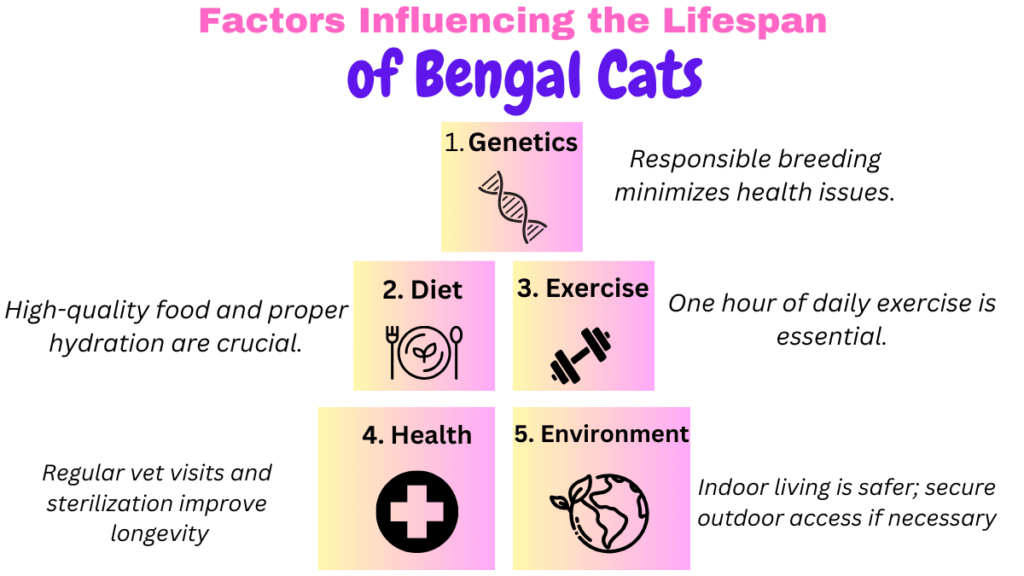
Genetics
When it comes to genetics, they play a huge role in determining how long your Bengal cat might live. Bengals are a delightful mix of two breeds, giving them more genetic variety when bred correctly. However, inbreeding can spell trouble, leading to health issues like hypertrophic cardiomyopathy (HCM) and progressive retinal atrophy (PRA). That’s why choosing a responsible breeder is a must.
Here’s the scoop: go for a breeder who prioritizes health. They should be testing their breeding cats for genetic conditions like PRAb and PK Deficiency and regularly scanning their cats’ hearts, ideally up to eight years old. This is the basic health info any Bengal breeder should have on their cats.
Diet and Nutrition
A balanced diet is key to a long, healthy life for your Bengal cat. High-quality, nutrient-rich food helps maintain their energy levels and overall health. Ensuring your Bengal gets the right balance of proteins, fats, and vitamins can prevent obesity and other diet-related issues, ultimately contributing to a longer life.
A poor homemade diet can be more dangerous than a poor commercial one. Additionally, cats evolved to get most of their water from their food. Feeding them dry food can lead to constant low-grade dehydration, which taxes their organs and causes many illnesses, especially in middle-aged and elderly cats.
Opt for high-quality wet food or a raw cat food diet with high water content to ensure your Bengal stays hydrated and happy for years to come. Remember, both quality and frequency make a huge difference when feeding a Bengal.
Note: Calorie count is also crucial—Bengals need more calories than other cats because they are so active. Be careful not to overfeed or underfeed them. For a bit of help, use our cat calorie calculator and set it to active cats to get an estimate.

Exercise and Mental Stimulation
Bengal cats are little bundles of energy that need plenty of exercise and mental stimulation to stay happy and healthy. Without enough activity, they can develop behavioral issues and even reduce their lifespan. As a rule of thumb, aim for at least one hour of exercise each day, split between interactive play with you and solo play sessions.
Interactive toys, climbing structures, and engaging play sessions are crucial for their well-being. Think feather wands, laser pointers, and puzzle toys that challenge their minds.
Healthcare and Sterilization
Regular check-ups, vaccinations, and preventive measures such as flea and tick control can significantly enhance your Bengal cat’s quality of life. Dental care is also crucial, as periodontal disease can lead to more severe health problems if left untreated. Cats often hide signs of illness until it’s too late, so regular vet visits are essential for catching issues early.
Sterilization also plays a critical role in your Bengal’s health and longevity. Neutered or spayed Bengals are typically healthier and tend to live longer. Sterilization can reduce aggressive behaviors like biting and scratching and lower the urge to wander off searching for a mate, which reduces the risk of accidents and injuries.
Note: Neutering males eliminates the risk of testicular cancer and significantly reduces the likelihood of prostate issues. Spaying females prevents uterine and ovarian cancers and decreases the risk of breast cancer and pyometra, an infection of the uterus.
Living Environment: Indoor vs. Outdoor Living
The living environment of your Bengal cat plays a significant role in their lifespan. Indoor cats are generally safer from accidents, predators, and infectious diseases. Staying indoors protects your Bengal from these risks and ensures a safer life.
However, if you choose to allow outdoor access, consider a secure outdoor enclosure or “catio” to provide a safe space for exploration. Walking your Bengal on a leash is also a great way to safely expose them to the outdoors.
Common Health Issues in Bengal Cats
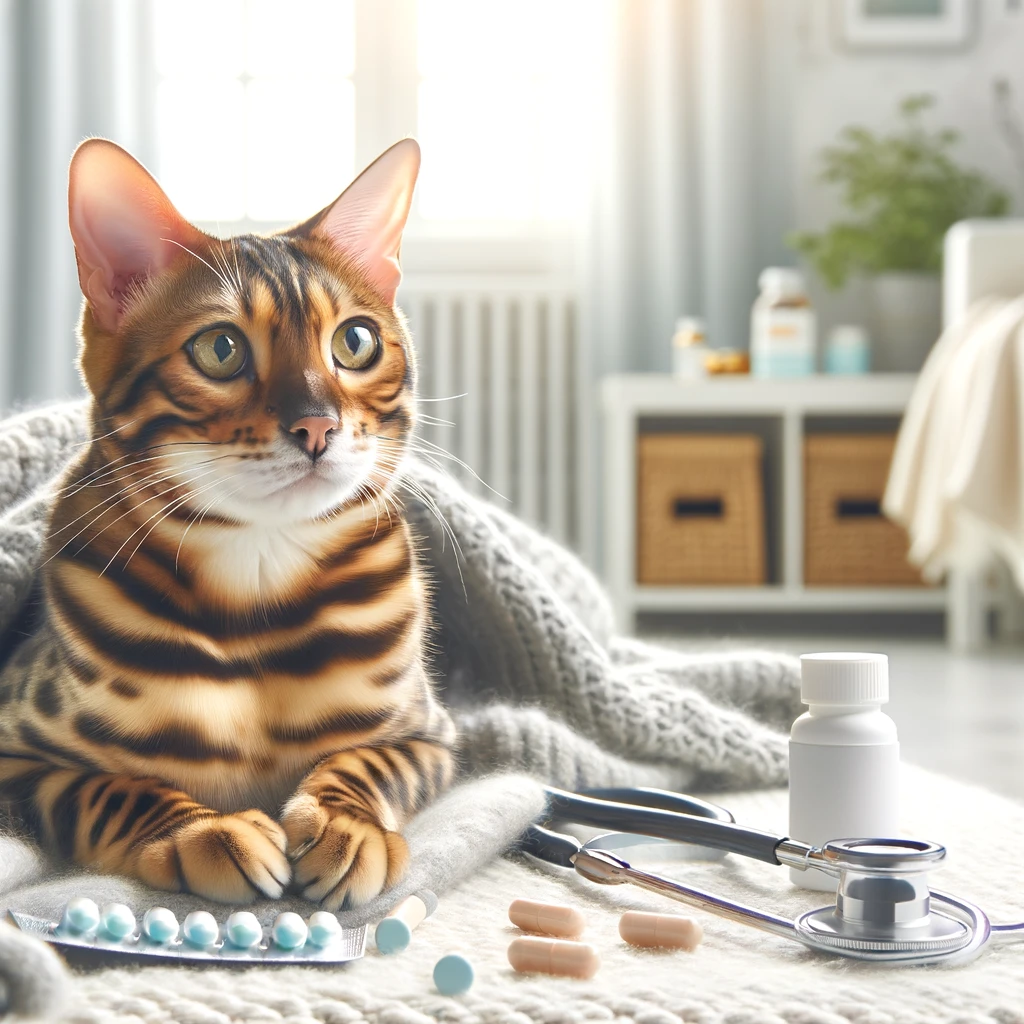
While Bengal cats are generally healthy, they are prone to certain health issues that owners should be aware of. By understanding these common health problems, you can take proactive steps to ensure your Bengal cat leads a long and healthy life.
Hypertrophic Cardiomyopathy (HCM)
Hypertrophic cardiomyopathy (HCM) is a common heart disease in Bengal cats. This condition causes the heart muscle to thicken, leading to potential heart failure. Regular veterinary check-ups and heart screenings can help detect HCM early, allowing for better management of the condition.
Progressive Retinal Atrophy (PRA)
Progressive retinal atrophy (PRA) is another genetic disorder affecting Bengal cats. PRA leads to gradual vision loss and can eventually result in blindness. While there is no cure for PRA, early detection through regular eye exams can help you adapt your home environment to accommodate a visually impaired cat.
Patellar Luxation
Bengals are prone to joint problems like patellar luxation—where the kneecaps dislocate. If your Bengal is experiencing mild patellar luxation, it might not be obvious at first, which is why regular vet check-ups are crucial. Treatment can range from arthritis medication to surgery, depending on the severity.
Dental Issues: Periodontal Disease
Periodontal disease affects the gums and structures supporting the teeth, leading to pain, infection, and tooth loss. Regular dental care, including brushing your cat’s teeth and providing dental treats or toys, can help prevent periodontal disease. Annual dental check-ups are also essential for maintaining your Bengal cat’s oral health.
Feline Leukemia Virus (FeLV) and Feline Immunodeficiency Virus (FIV)
Bengal cats are susceptible to infectious diseases such as the feline leukemia virus (FeLV) and the feline immunodeficiency virus (FIV). Both viruses weaken the immune system, making cats more prone to other infections and diseases. Vaccination is crucial in preventing FeLV, while regular health checks can help detect FIV early. Keeping your Bengal cat indoors or in a secure outdoor space can also reduce the risk of exposure to these viruses.
Signs of Aging in Bengal Cats
As Bengal cats age, they may exhibit certain behavioral and physical changes. Recognizing these signs can help you adjust their care to ensure they remain comfortable and happy during their senior years.
Behavioral Changes
Older Bengal cats may become less active and playful compared to their younger selves. You might notice they spend more time resting or sleeping. Some senior Bengals may also become more vocal, seeking attention and comfort. Changes in litter box habits or increased anxiety can also indicate aging.
Physical Signs: Weight Loss and Changes in Coat Condition
As Bengal cats age, they may experience weight loss due to decreased muscle mass and metabolic changes. Their coat might also lose its luster, becoming thinner or more brittle. Regular grooming helps maintain their coat’s health and comfort.
Other signs include cloudy eyes or enlarged blood vessels in the eyes, as well as dry, less elastic skin, which can lead to more skin infections or odors.
Pro Tip: After age twelve, it’s normal for cats to lose about one pound of body weight, though some may gain. Adjust their diet to meet senior nutritional needs. If there’s significant weight loss, check with a vet.
Joint Problems
As Bengals age, they may develop arthritis or other joint issues. You might notice them moving more slowly, being less willing to jump or climb, or showing signs of discomfort when moving. Providing joint supplements and ensuring they have soft, supportive bedding can help alleviate discomfort.
Dental Issues
Dental health often declines with age. Older cats can develop periodontal disease, tooth decay, and gingivitis. Regular dental check-ups and proper oral hygiene can help prevent these issues and keep your Bengal’s teeth and gums healthy.
Ensuring a Long and Healthy Life for Your Bengal Cat
While genetics play a significant role in determining the lifespan of Bengal cats, we, as their caregivers, have a substantial impact on their health and well-being.
By understanding common health issues, recognizing signs of aging, and providing attentive care tailored to their needs, we can help our Bengal cats live long, healthy, and happy lives. Let’s commit to doing our best for our feline friends, ensuring they thrive at every stage of their life.
Meet Sean, a fintech whiz with a penchant for pet purrs and blockchain buzz. After a decade of fintech feats, Sean's tech talents leaped from ledger lines to litter lines, driven by a passion for pets and a vision for a more connected pet care community. With three critter companions as co-pilots, Sean launched this blog to share a treasury of pet-friendly tech tips and tales.

